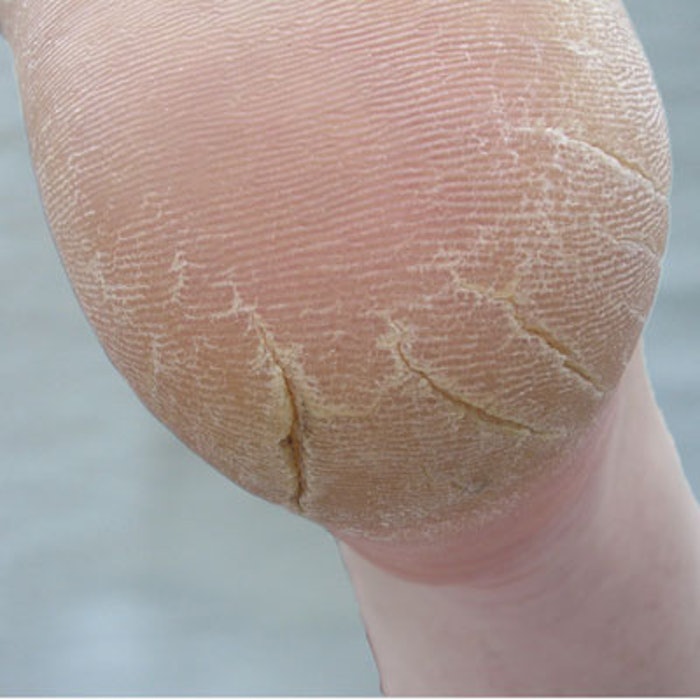
As a nail tech, you must be prepared to recognize–and know how to handle–a foot malady before the first swipe of your file. Here, we identify four common foot issues and offer up expert advice for effective client care.
Learn How to Identify and Address Four Major Foot Problems
Athlete’s Foot
 Athlete’s foot is a highly infectious fungal infection.
Athlete’s foot is a highly infectious fungal infection.Athlete’s foot is the layperson’s term for a fungal infection, or tinea pedis. Although it usually only afects the superficial layers of the skin, the problem isn’t superficial at all; the infection is easily picked up, especially via exposure of feet and contact with communal areas, such as locker rooms and showers. The condition shows up as dry, flake, scaly skin between the toes and around the sides of the foot, accompanied by intense itching and burning. Another less obvious presentation of the disorder, notes Katharin Von Gavel, founder and CEO of Footlogix, “is dry or rough feet, to the point where they catch on bedsheets at night. But, moisturiers just don’t work.” She adds that today’s practice of wearing flip-flops leaves our feet more prone to drying out. The dry skin then creates portals through which fungi can enter. Middle-aged and elderly women are especially vulnerable to this problem.
What should techs do?
If you suspect your client has a fungal infection, assess the severity. “If the skin is inflamed, broken or weeping, it’s best not to treat the client,” says Kristin Hudacek, M.D., a board-certified dermatologist at Richard G. Glogau M.D., Inc. in San Francisco. “Any client with suspected athlete’s foot should be urged to see a board-certified dermatologist.” Additionally, infection control is crucial, as cross-contamination is a threat. “Wear gloves,” advises Hudacek. “After the pedicure, discard or sanitize any used tools to prevent spreading the infection to other clients.”
What should clients do?
Although nail techs cannot diagnose, you can suggest clients try a moisturizer with an antifungal and advise them to change shoes and socks frequently, avoid exposure in common areas and keep feet in good condition to lower risk of infection. You should also encourage clients to see a medical professional; There are many OTC and prescription preparations for treating tinea pedis.
Cracked Heels
 Severely cracked heels can not only be painful, but dangerous as well.
Severely cracked heels can not only be painful, but dangerous as well.Cracked heels arise from dry, dead skin that has built up over time–the resulting thick calluses split and cause pain. In some cases, the cracks are deep enough to bleed because they’ve gone into the epidermal layer. Not only is this condition painful, it can be dangerous, as it leaves the body open to viral, fungal or bacterial infection.
What should techs do?
Whether a client with cracked heels should receive a pedicure depends upon the individual case. “If the cracks are deep and painful, it’s best to not treat and to refer the client to a dermatologist,” says Hudacek. “If the cracks are superficial, soak the client’s feet in water first, then gently exfoliate with a scrub or pumice, stopping if they report any pain.” Von Gavel suggests use of a non-acid-based callus softening product and filing with a sterilizable or single-use foot file, moving in the direction of the crack.
What should clients do?
If cracks aren’t deep enough to require medical attention, the solution is consistent home and professional care focused on exfoliation and hydration to help the skin heal.
Bunions
 Bunions are a deformity that appear on the side of the big toe.
Bunions are a deformity that appear on the side of the big toe.A bunion is a progressive deformity of the joint of the big toe, usually due to an inherited faulty mechanical structure in the foot, and it appears as a bump on the side of the big toe. Although it isn’t always painful, bunions are still the most common reason for foot pain, and can cause inflammation and even numbness.
What should techs do?
“It’s safe for someone with a bunion to receive pedicures,” says New York City podiatrist Jeffrey L. Adler, D.P.M. “However, the tech should be aware and have the client state if there’s any pain.” Von Gavel cautions nail techs to look out for calluses or blisters in the area. “Exfoliate the callus on a bunion, but not too much, especially for diabetic clients,” she says. “There’s potential for ulceration, which could cause a life-threatening infection.”
What should clients do?
Shoes don’t cause bunions, but high heels or a tight toe box can worsen the condition. Bunion pads, icing and anti-inflammatory medications can provide relief–if not, doctors can offer injection therapy, orthotics or surgery.
Plantar Warts
 Plantar warts are caused by the HPV virus.
Plantar warts are caused by the HPV virus.Plantar warts are caused by the human papillomavirus (aka, the HPV virus). “They look like rough bumps that disrupt the “fingerprint” lines on the palms of hands and soles of feet,” says Hudacek. “They are harmless, but can be painful to walk on.” If not in a weight-bearing area, a wart can go undetected for years. The bumps may resemble a callus, but with tiny black dots on their surface (from dried blood contained in the capillaries).
What should techs do?
Even with the use of gloves, warts are so contagious that it’s best for nail techs not to work on clients who have them.
What should clients do?
Although some home remedies exist, doctors urge patients with warts to never try to remove them at home. Topical and oral treatments, laser therapy, cryotherapy, acid treatments or surgery are available.
Linda Kossoff is a health and beauty writer based in Los Angeles.
Images for Athlete’s Foot, Cracked Heels and Bunions, courtesy of Footlogix; Plantar Wart via happyfeet34/Flickr.











